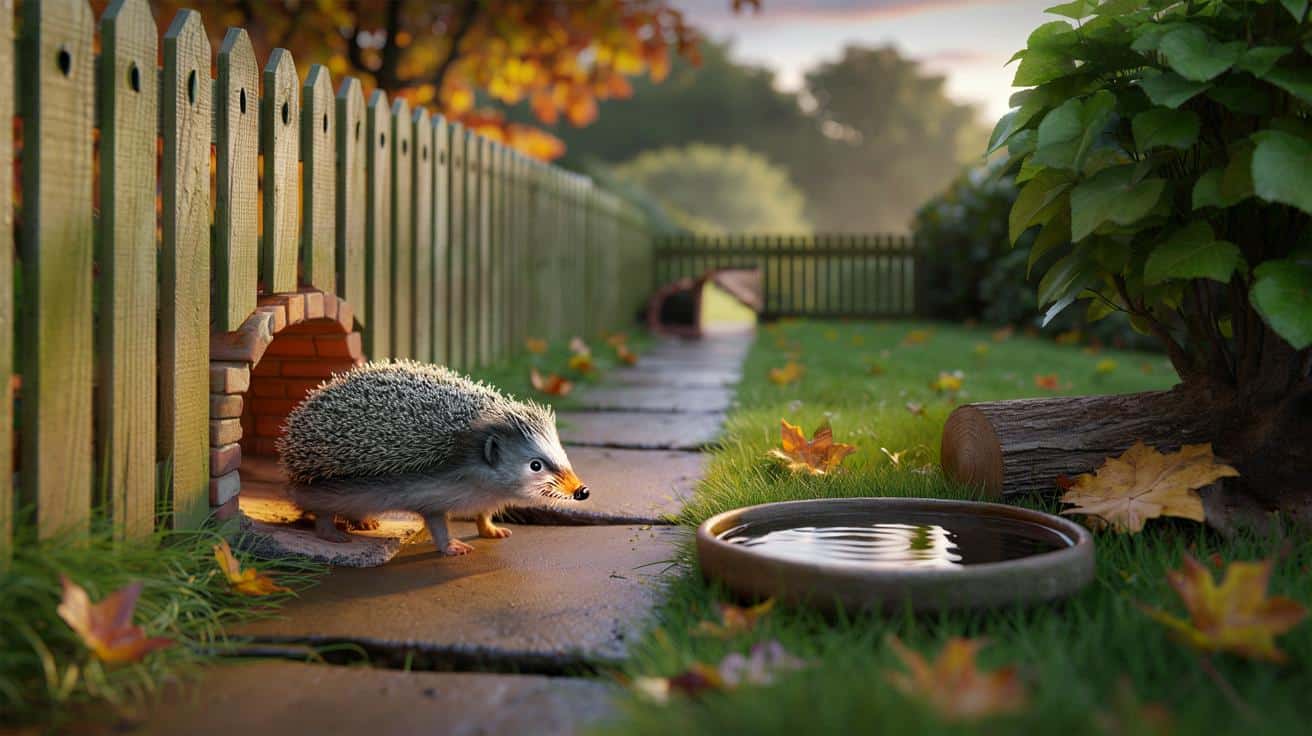A small tweak can change the balance.
Across the UK, gardeners report chewed hostas, nibbled strawberries and empty water bowls by dawn. Those clues point to a helpful guest. With temperatures dropping and hibernation weeks away, one simple change this month can turn your plot into a safe stopover for wildlife that also protects your plants.
One small gap, big nightly journeys
Hedgehogs roam roughly a mile each night, moving between gardens to feed and shelter. High, solid boundaries trap them out or in, breaking that nightly circuit. October is the moment to fix it, because they are building fat reserves before their winter sleep.
Cut a hedgehog highway: a 13cm x 13cm opening at ground level in a fence or under a gate lets hedgehogs pass while keeping most pets in.
Measure at the base of a fence panel and mark a square 13cm by 13cm. Use a hand saw to keep control near gravel boards or posts. Smooth any sharp edges. If you cannot alter the panel, dig a shallow channel beneath a gate and slot in a short section of pipe with a 13cm internal diameter to form a tunnel.
Worried about a small dog? Place the opening through the panel rather than beneath it, 5–7cm above ground, and add a short 20–30cm tunnel inside your boundary using bricks or a terracotta pipe. This deters pets but still fits a hedgehog’s profile.
Talk to neighbours before you start. Two aligned openings double the value of your work and create a corridor across several plots. A row of connected gardens becomes a reliable nightly route that hedgehogs learn and return to.
Why October matters for hedgehogs and your plants
Hedgehogs help without fuss. They eat slugs, snails and beetles that gouge holes in foliage and fruit. As days shorten, natural food can run low, so a safe route, access to water and a bit of supplementary food gives them a boost before hibernation, usually from November to March.
Fresh water beats everything else. A shallow dish filled daily is the single fastest way to support night visitors.
Skip the milk. Hedgehogs cannot digest lactose. Offer a handful of meaty, jelly-based cat or dog food, or hedgehog biscuits, in a heavy, low bowl. Put food out at dusk and remove leftovers at dawn to avoid attracting rats. If a hedgehog appears in daylight, or a small autumn juvenile looks underweight, contact a local rescue for advice.
Make shelter they actually use
Quick fixes you can do today
- Stack a log pile in a shaded corner; leave dry leaves between logs for insulation.
- Lean a sturdy board against a wall to form an instant dry refuge with a narrow entrance.
- Keep a “wild corner” where leaves, twigs and prunings collect. That mess is prime nesting material.
Place shelter away from main paths and doors, in a spot that stays quiet and out of prevailing wind. Avoid moving it once occupied.
Going further with a house
A purpose-built hedgehog house adds protection from dogs, foxes and bad weather. Choose one with an internal dividing wall and a tunnel entrance to block draughts. Site it on bare soil so occupants can dig and stay dry. Camouflage with leaves. Resist the urge to peek after mid‑October; let them settle.
| Action | Exact spec | Typical cost | Time |
|---|---|---|---|
| Access hole | 13cm x 13cm at ground level | £0–£5 (hand saw/edge trim) | 15–25 mins |
| Water | Shallow, heavy dish refreshed daily | £0–£3 | 2 mins |
| Food | 50–100g meaty cat food or hedgehog biscuits | £0.50–£1 per night | 2 mins |
| Shelter | Log pile or board lean-to in shade | £0 | 10–20 mins |
| Safety check | Inspect compost/leaf piles before lighting fires | £0 | 1–3 mins |
Five-minute wins that pay back all winter
- Check netting and garden football goals; raise the lowest edge to at least 10cm to stop tangles.
- Float a wooden ramp in ponds so hedgehogs can climb out; bricks on the shelf work too.
- Cover drains and holes; they trap small mammals on cold nights.
- Rake leaves towards borders, not into bags; they form soft bedding under shrubs.
- Keep security lights on sensors; constant glare deters nocturnal visitors.
Skip chemical shortcuts. Metaldehyde slug pellets are no longer permitted in Great Britain. Ferric phosphate pellets are allowed, but hedgehogs handle many slugs for free if you offer access, water and cover. Beer traps also drown beneficial insects, so place them, if you must, inside a raised container that wildlife cannot fall into.
What not to put out
Milk causes stomach upsets. Bread fills stomachs without nutrients. Dried mealworms and peanuts can lead to mineral imbalance if offered often. If you feed, stick to meat-based wet food, complete hedgehog biscuits and fresh water.
Food helps in cold snaps, but habitat beats handouts. Access, shelter and water support hedgehogs long after the bowl is empty.
Spot the signs and stay hedgehog-safe
By morning you may see shiny droppings, small tracks through dew, or tunnels in leaf piles. Before using a strimmer, pat long grass and edges with a stick. Lift compost lids carefully. If you plan a bonfire, rebuild it on the day you light it; piles assembled earlier often hide resting hedgehogs.
Your garden, their corridor
Britain’s hedgehogs now sit on the national list of species vulnerable to extinction. Gardens can stitch together safe paths across streets that otherwise block movement. One hole in one fence helps, but a chain of holes along a terrace turns back lanes, borders and sheds into useful habitat. Speak to the neighbour on both sides; two conversations multiply your results.
A simple plan for this weekend
Pick a boundary. Cut one 13cm x 13cm opening. Put a shallow dish of water near cover. Heap a small log pile against a rear fence. Share a photo of the hole with your street group and ask who wants to line theirs up with yours. That hour of work reduces slug damage now and gives hedgehogs a route to safety before the first frost.
Extra help if you have children or pets
Create a watching window: place the water bowl within view of a low window and switch lights off after 8pm. Show youngsters how to stay quiet and hands-off. For dogs, place feeding and water dishes behind a low plant barrier or inside a simple wooden tunnel so only hedgehogs fit through.
If you want to go a step further
Weigh up a small night-time camera to confirm visits; many low-cost models record short clips when they detect movement. Keep a notebook of dates and weather. Over time you will spot patterns, like damp nights drawing more slugs and more hedgehog activity. If you manage an allotment, ask the committee to approve standard 13cm holes along shared fences and to post a seasonal reminder to check compost heaps before fires.
Think about scale. Four adjacent gardens connected by aligned holes can create a continuous foraging area greater than the sum of its parts. Add a hedgehog house in one plot, a pond ramp in the next, nightly water in a third and a leaf pile in the fourth; together you build a safe circuit that works even when one source of food runs low.









Love this! I cut a 13cm x 13cm “hedgehog highway” last year and slug damage dropped loads. A shallow water dish daily is definitley a game‑changer. Sharing with my neighbours this weekend 🙂